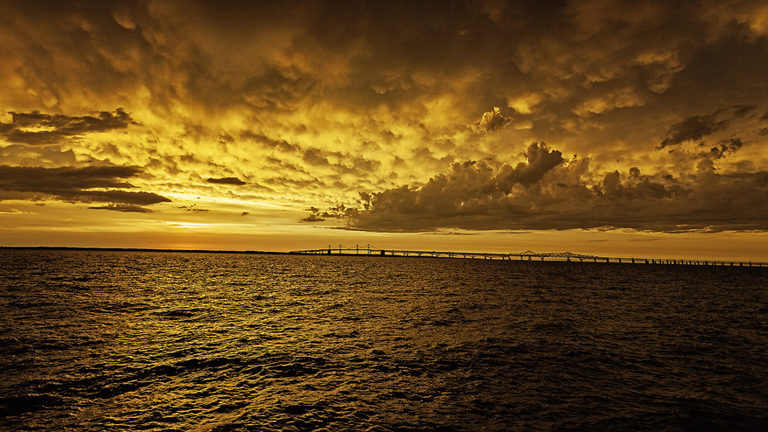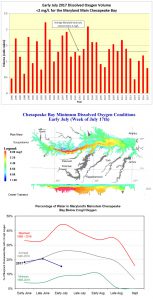Early July 2017 Hypoxia Report

photo by by Krystle Chick
Dissolved oxygen conditions in Maryland’s portion of the Chesapeake Bay mainstem were much better than average for early July, reports the Maryland Department of Natural Resources.
The hypoxic water volume (areas with less than 2 mg/l oxygen) was 0.78 cubic miles, which is much smaller than the early July 1985-2016 average of 1.3 cubic miles. No anoxic zones (areas with less than 0.2 mg/l oxygen) were detected. Crabs, fish, oysters and other creatures require oxygen to survive with levels above 5 mg/l considered optimal to support aquatic health.
The better-than-average conditions could be partially attributed to sustained westerly winds during the sampling period, which mixed oxygen deeper into the water column in the main bay channel. The winds, however, pushed surface waters eastward, allowing lower dissolved oxygen bottom waters to percolate toward the surface on the western side of the lower bay.
Winds and rough water conditions prevented station CB5.3, a center bay channel station near the Maryland and Virginia state line, and the lower Potomac station LE2.3 from being sampled. It should be noted that the absence of data from these stations could produce lower than average estimates of hypoxia.
In the lower center bay, habitat improved with non-hypoxic conditions stretching from the surface down to about 33 feet deep, an improvement from a late June result of 25 feet. More on fishing and fish habitat conditions can be found on the new “Click before you Cast” webpage.
In the beginning of June, the National Oceanic and Atmospheric Administration, U.S. Geological Survey, University of Maryland Center for Environmental Science and University of Michigan scientists predicted a slightly larger than average hypoxic volume for the bay due to higher spring flows (January-May) and nitrogen loading from the Susquehanna River.
Scientists and natural resource managers study the volume and duration of bay hypoxia to determine possible impacts to bay life. Each year (June-September), the Maryland Department of Natural Resources computes these volumes from data collected by Maryland and Virginia monitoring teams. Data collection is funded by these states and the Environmental Protection Agency’s Chesapeake Bay Program. Monitoring and reporting will continue through the summer.
More information on Maryland’s Chesapeake Bay water quality monitoring program and results can be found here.

